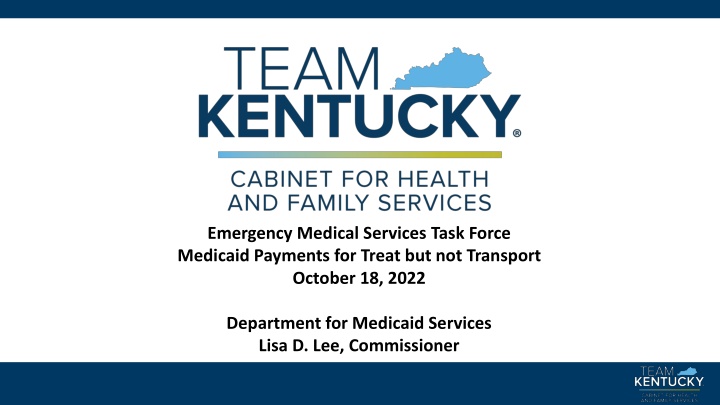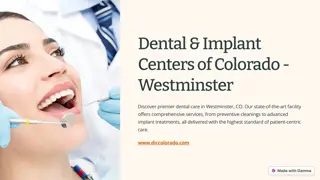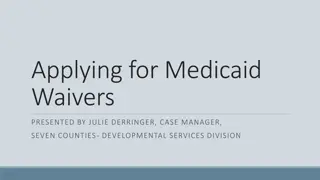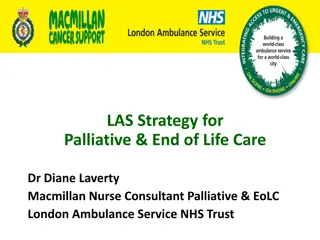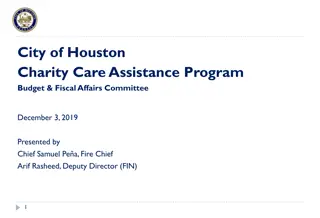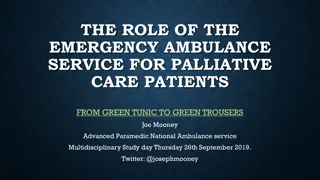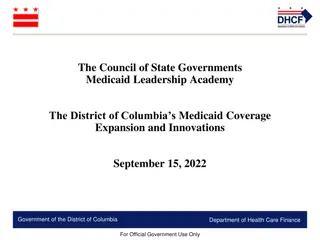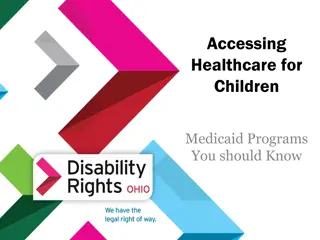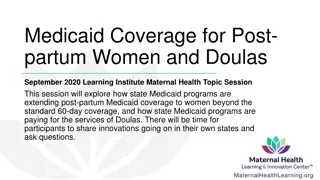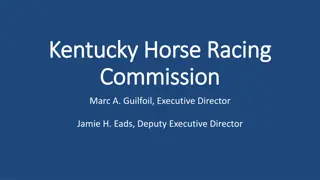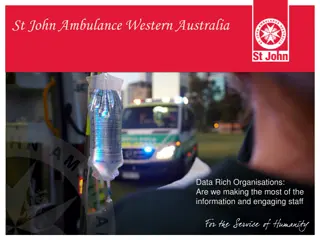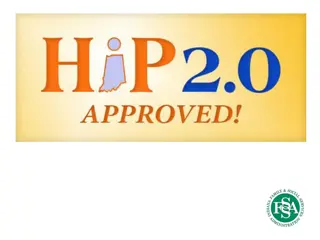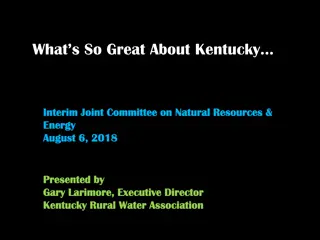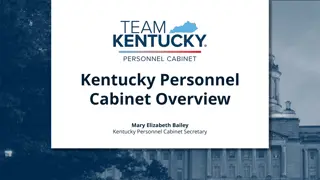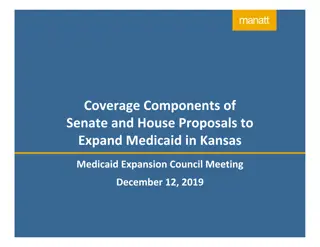Kentucky Medicaid: Ambulance Services Coverage Overview
Kentucky Medicaid provides coverage for ambulance services including ground or air transportation at different levels of care, documentation requirements, and conditions for non-emergency transportation within and outside the medical service area. The program also outlines provisions for non-emergency medical transportation and contracts with regional brokers through the 1915(b) waiver.
Download Presentation

Please find below an Image/Link to download the presentation.
The content on the website is provided AS IS for your information and personal use only. It may not be sold, licensed, or shared on other websites without obtaining consent from the author.If you encounter any issues during the download, it is possible that the publisher has removed the file from their server.
You are allowed to download the files provided on this website for personal or commercial use, subject to the condition that they are used lawfully. All files are the property of their respective owners.
The content on the website is provided AS IS for your information and personal use only. It may not be sold, licensed, or shared on other websites without obtaining consent from the author.
E N D
Presentation Transcript
Emergency Medical Services Task Force Medicaid Payments for Treat but not Transport October 18, 2022 Department for Medicaid Services Lisa D. Lee, Commissioner
Kentucky Medicaid at-a-Glance Approximately 1.6 million members Over half of Kentucky s children are covered under Medicaid and KCHIP Approximately 625,000 covered under Medicaid expansion (ACA) Approximately 1 million covered under traditional (Non-ACA) Over 60,000 enrolled providers Medicaid managed care organizations State fiscal year (SFY) 2022 budget - $14.8 billion $78.5 million in capitation payments for non-emergency transportation (NEMT) in SFY2022 2
Medicaid Coverage for Ambulance Services Ambulance transportation: ground or air transportation provided at advanced life support level or basic life support level by a carrier licensed by the Kentucky Board of Emergency Medical Services Emergency Ambulance services covered to and from a hospital emergency room in the medical service area Documentation for post-payment review required Transportation to an appropriate medical facility other than hospital shall require documentation from attending physician of: Medical necessity Absence of hospital emergency room in the medical service area Delivery of emergent care to the patient 4
Medicaid Coverage for Ambulance Services Nonemergency Transportation to a provider within the medical service area if: Member s medical condition warrants transport by stretcher Member is traveling to or from a Medicaid-covered service, excluding pharmacy Service is the least expensive available for the member s needs Transportation outside of the medical service area if: All items above are met Medical service required by the member is not available in medical service area Member is referred by a physician 5
Non-Emergency Medical Transportation (NEMT) 1915 (b) waiver Contract with Office of Transportation Delivery (OTD) OTD contracts with regional brokers Brokers are paid a per-member-per-month (PMPM) capitation fee Brokers contract with transportation providers or provide transportation Taxi, van, bus, and public transit, but excludes ambulance stretcher services Members call brokers to schedule NEMT within 72 hours of appointment time when free transportation is not available Must provide urgent care services as specified in 42 CFR 438.206(c)(1)(iii) Make services included in the contract available 24 hours a day, 7 days a week, when medically necessary 6
HB8 (2020 session) Ambulance Provider Assessment Program (APAP) Provider tax funding: State share of payments funded by the new provider tax Tax is flat 5.5% of cash collections for emergency ground transports from all payors (tax is on all payors and enhancements are paid on Medicaid only) Gross revenues should be reported only for transports originating in Kentucky as defined in KRS 142.301 and the draft regulation 907 KAR 3:060 All Class I III ground ambulance providers will be taxed regardless of Medicaid utilization Quality measures for the program are: Promote access to high-quality care by reducing ambulance response times Increasing the number of certified EMS practitioners 7
HB8 (2020 session) Ambulance Provider Assessment Program (APAP) Authorizes enhanced payment programs for fee for service (FFS) and managed care organization (MCO) ground ambulance services First program year was CY 2021 but requires to be approved every year Annual add-ons are applied to historical utilization to determine interim payments and paid monthly (approximately $3.8m/month). A final reconciliation to actual utilization will be performed after appropriate claims adjudication has occurred. CY 2021 (total payments) = $45,393,208.86 CY 2022 (thru August 2022) = $29,758,948.20 8
CMS Emergency, Triage, and Transport (ET3) Model August 8, 2019 issued informational bulletin Proposed 5-year payment model to provide greater flexibility following 911 call by Medicare fee-for-service beneficiaries Would reimburse for: Transportation to alternative destination, such as primary care office, urgent care clinic, or community mental health center Initiation and facilitation of treatment in place with a qualified health provider at the scene or via telehealth September 13, 2021 plan was withdrawn and not implemented Emergency Triage, Treat, and Transport (ET3) Model | CMS Innovation Center 10
Medicare Ambulance Coverage Medicare Part B only covers to the nearest appropriate medical facility: Hospital Critical access hospital, or Skilled nursing facility 11
Medicaid Coverage of Treatment Without Transportation Indiana covers through Medicaid state plan amendment (SPA) Massachusetts exploring but no SPA or waiver submitted Oregon covered ambulance treat in place during COVID through a temporary state plan amendment Tennessee anticipates implementation of treat in place or transport to alternate destination in CY2023 100% MCO no plans for SPA or waiver Minnesota only if the ambulance transportation staff provided medically necessary treatment to the member at the pickup point West Virginia allows A0998 to be billed for treat no transport without modifier with modifier for administration of Naloxone through 1115 waiver specific to substance use disorders (SUD) 12
State Plan Amendment (SPA) vs. 1115 Waiver SPA is an agreement between state and Centers for Medicare and Medicaid Services (CMS) describing how the state will administer the Medicaid program Statewide Comparability cannot change services for one group of Medicaid enrollees Choice of providers 1115 Research and Demonstration Project waiver Request to bypass certain federal Medicaid requirements Budget neutrality 5-year limitation with renewal periods 13
What would a waiver look like? Define what we want to waive: Statewide or limited to specific geographic area Define specific providers waive freedom of choice Define population SUD as in West Virginia, for example Develop budget neutrality and reporting requirements 14
Next Steps if Directed to Cover Treatment without Transport Conversation with CMS Creation of SPA or waiver Treatment without transport could be accomplished through SPA Amend transportation regulations Anticipate $5 million budget impact Timeframe Collaboration 15
